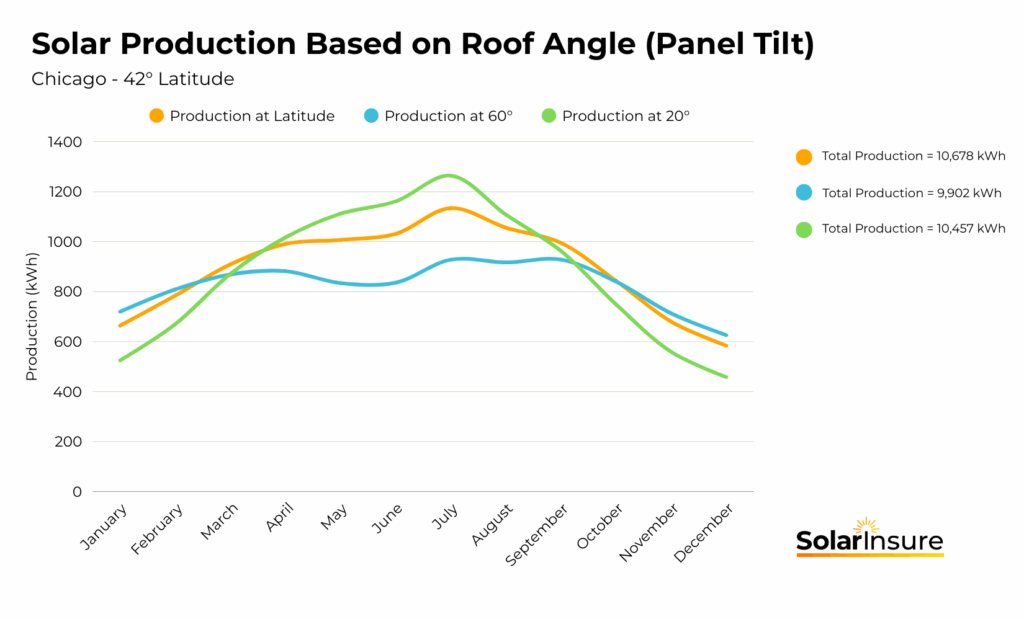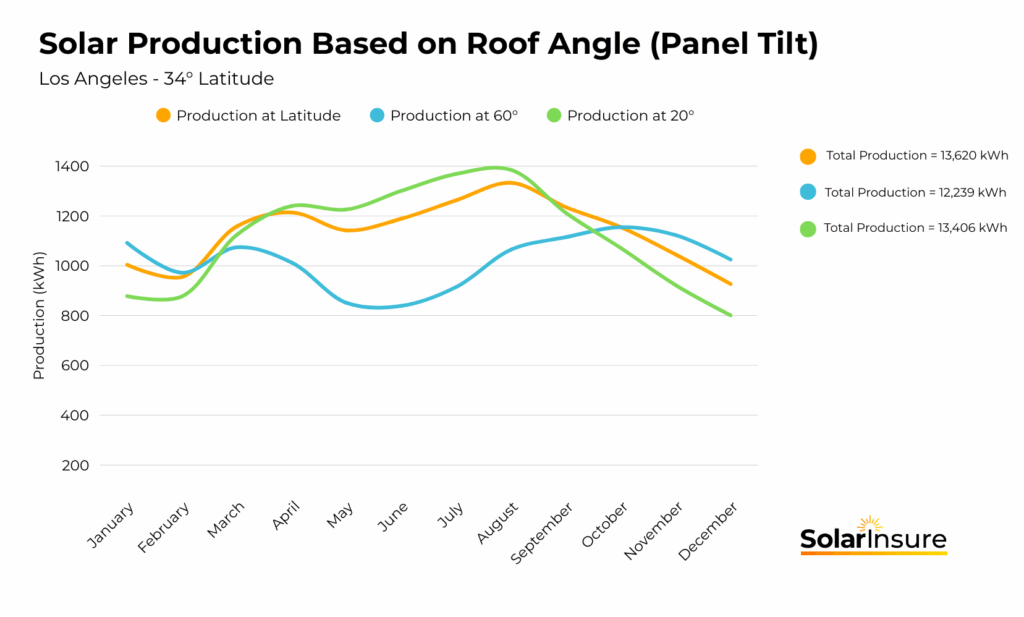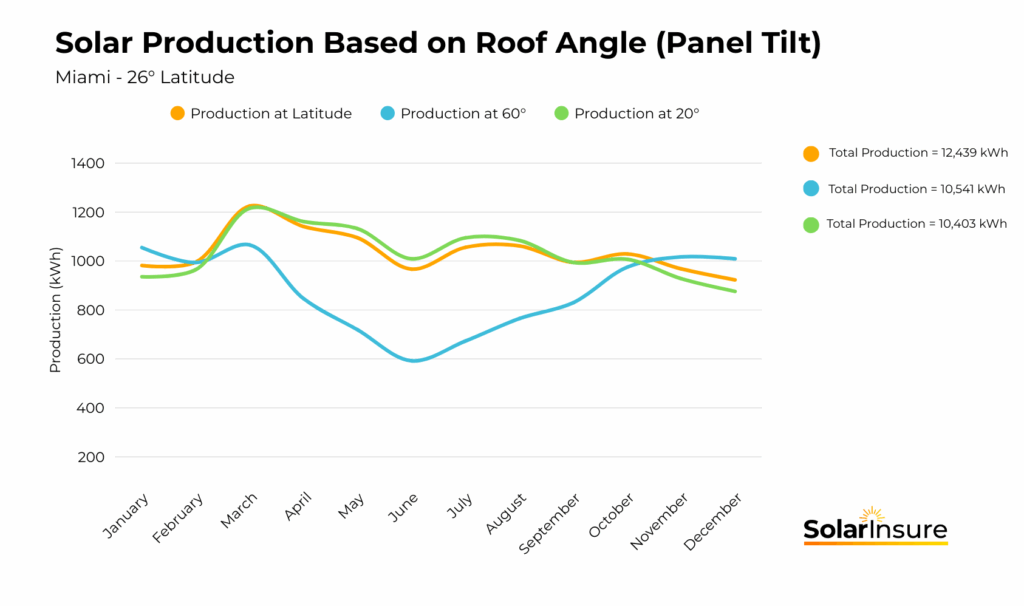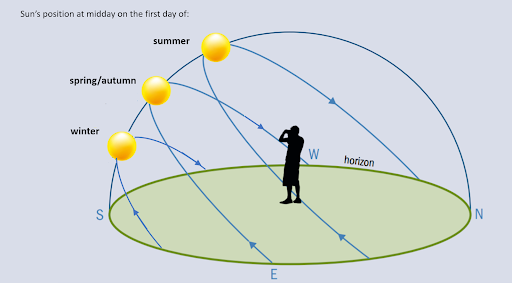Roof angle, and thus the angle panels will be positioned, is normally of little concern to the average homeowner getting solar quotes, but can drastically affect the production of their solar panels. In the majority of cases, homeowners receive quotes from a solar installer that simply puts panels on the roof planes with the most solar access and goes on with their day.
But if a home has multiple roof angles, what is the difference between them? We ran the numbers so you don’t have to.
Table of Contents
The Science of Sun Angle
To begin to understand the effect panel angles have on production, we first need to know why production is different throughout the year. Production changes, and seasons for that matter, occur because of the sun’s angle.
In the summertime, the sun is higher in the sky and visible for longer periods. Due to the greater amount of sunshine, solar panels will always produce more in the summer. In the winter months, the sun angle is lower and is only visible for fewer hours, so production is always lower in the winter.
When it comes to solar production, direct sunlight produces the most energy in panels. In an ideal situation, a solar panel would be perpendicular to the sun at all times to always be receiving the most direct sunlight possible. This is why there is a growing popularity among commercial installations to use “tracker” systems that follow the sun through the day or throughout the year, to produce as much energy as possible.
Tracking Solar Arrays
Solar tracking systems come in two varieties:
- Single-Axis Tracking: Panels can move from east to west, following the sun from sunrise to sunset
- Dual-Axis Tracking: Panels move east to west following sunrise and sunset and can adjust tilt according to the sun’s angle on that day.
Tracking systems are rare to see in residential installations due to the significantly increased cost and requirement by many building codes that panels can only be mounted flush with a roof.
On residential scales, the additional cost of a tracking system typically outweighs any increase in production, but tracking is more feasible on the commercial and utility scales. Tracking systems can increase solar production by 30% to 40%.
Roof Angle Effect on Production
So, how do different roof angles affect production? While there are overall production differences depending on where the array is located, the same general principles apply to all systems.
The study we ran looked at three different locations across the mainland United States at varying latitudes. The three locations, Chicago, Los Angeles, and Miami, vary from 26° latitude to 42° latitude. For each location, we ran tests to see what estimated solar production would be at a low roof angle (20°) steep roof angle (60°), and a roof angle that matches the latitude.
To run these calculations, we used the National Renewable Energy Lab’s PV Watts estimator. Other than the locations and angles, all variables were kept the same in each simulation. The simulations used “standard” panels, an 8 kW system, at 180° azimuth, meaning the system faced directly south. PV watts takes system losses into account as well as weather data for the area. Here are the results:



The numbers at these various locations tell an interesting story. In each of the three areas, the simulation with panels at 20 degrees produced the most power in the summer time, but ended up being the lowest in the winter months. Conversely, the 60° pitch had the lowest production in the summer but the highest production in the winter months for all three locations. This follows along well with the idea of sun angles discussed earlier.
In the winter months, the sun angle is lower in the sky, so a higher angle for panels produces more energy because the panels are more perpendicular to the sun. In the summertime, the higher angle of the sun is more perpendicular with the 20° pitch, producing the most energy.
Across all the simulations, the angle matched to latitude only led production during the spring and fall periods, but overall produced the most power.
So why is this? When panels are matched to the latitude of the area they’re installed in, the difference between the sun angle and the panel angle is less during a larger part of the year. As opposed to the 20° or 60° models that spend more of the year at a greater difference in angle. Because the latitude angle is closer to perpendicular at more times of the year, the overall production is greater.
What can Homeowners Going Solar Do with this Information?
While those trends are great to know, how can homeowners or solar installers use this information to their advantage? It all depends on what the goals and situation of the homeowner are.
In most cases, panels aren’t permitted to be installed angled on a roof. From a building code perspective, angling the panels upward creates greater force on the roof. If panels are angled up from the roof, they can catch wind like a sail and potentially cause structural damage to the roof. When they’re mounted flush to the roof, wind doesn’t have as large an effect.
But if your home has multiple roof angles, it can be beneficial to spread out panels so that solar production becomes more even throughout the year. Or, if a home has a larger portion of its energy consumption in the summer or winter, installing panels at an angle more appropriate for the season can reduce energy costs further.
In more and more of the country, electric utilities are moving away from net metering and fixed-rate electric prices for real-time variable pricing models and reduced credit for energy sent to the grid. If a homeowner’s electric utility increases prices in the summertime to keep up with high demands, installing panels at lower angles can save homes more money because production will be higher in those months.
Overall, solar installers and prospective solar buyers should take the time to understand their unique situation and utilize all available data to accomplish homeowners’ goals best.

